Weymouth
Visiting Weymouth
I am going to start blogging about the towns and cities that I have visited on my travels around the UK, to those that live there, most of these places don't seem that special and true these days there are very few destinations that can offer something totally unique to the traveller but in their own right each town and city is special.
A popular 'calling' for me is the coast, growing up in the midlands, the furthest you can get from the seaside in the Uk, it's not surprising that the watery shores of our fair isle have always interested me. The connection to family holidays when growing up is obvious and so the association with enjoyment and happiness will probably be forever buried in my psyche. Most recently I spent my first holiday at the popular seaside town of Weymouth, nestled on an attractive stretch of the Jurassic Coast in Dorset. Weymouth I had always been told was a nice place to visit, no one I had spoken to had ever told me that they hadn't enjoyed there stay and so I thought, 'it must be nice let's give it a try', thankfully I can say, I wasn't disappointed.
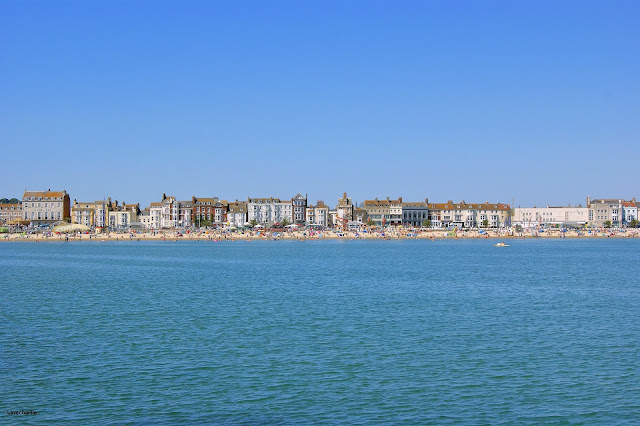 |
| Oh I Do Like To Be Beside The Seaside |
A Brief History Of Weymouth
Weymouth originally grew as an important harbour exporting wool and spices, during the 1530's two defences, Sandsfoot Castle and Portland Castle were built nearby to defend the South Coast from French invasion. The town even played a part in the colonisation of America when in 1635100 emigrants sailed across the Atlantic aboard the ship 'Charity' establishing the town of Weymouth, Massachusetts, more followed settling in Salem, Massachusetts and throughout Nova Scotia.In 1702 famous architect Sir Christopher Wren was the Member Of Parliament for the area, he also controlled the nearby Portland Quarries and it is stone from these quarries that he used in his most famous creation, the magnificent St Paul's Cathedral in London, interestingly James Thornhill who decorated the interior of the grand cathedral was also a local lad and the Weymouth Member of Parliament in 1722.
In the 1780s it became one of the first coastal destinations for those seeking relaxation and pleasure when a grand residence was built by King George III's brother, the Duke Of Gloucester, the king himself making the town his summer residence 14 times between 1789 and 1805, using a portable beach hut for him to change into his swimwear he even went for a paddle, a statue of the king (thankfully not in his bathing clothes) can be found prominently positioned on the promenade as well as a replica of his mobile beach hut.
 |
| Royal Sunbathing |
Following the arrival of the King more prominent and wealthy businessmen moved to the area and Weymouth started to transform into the seaside resort we see today, during the Georgian and Regency periods from around 1770 up until 1885 grand Georgian terraces were built lining the seafront, these former homes have since been converted into the hotels and shops that stretch along the promenade. In 1887 the Jubilee Clock, located in another prominent position along the promenade was erected to commemorate the 50th anniversary of Queen Victoria's reign.
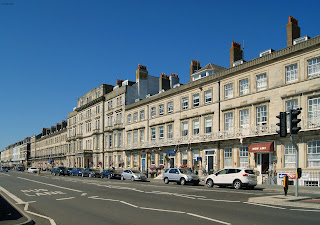 |
| Enjoy Your Stay Weymouth's Historic Seafront |
Weymouth played its part during the turbulent first half the 20th Century, during the First World War 120,000 ANZAC (Australian New Zealand Army Corp) troops convalesced in the town following the fighting in Gallipoli and other battles, there is a memorial to these men and women along the promenade. During the Dunkirk evacuation of World War II Weymouth sent out small boats to rescue the thousands of stranded allied troops on the French coast, while over 500,000 army personnel passed through the area on their way to the Battle Of Normandy, more commonly known as D Day, a Second World War memorial is also found along the promenade.
Throughout the Twentieth Century Weymouth remained a popular holiday destination thanks to its long sandy beaches and picturesque setting. In 2005 the Weymouth And Portland National Sailing Academy was chosen as the venue for the sailing events during the London 2012 Olympic and Paralympic Games, unsurprisingly this saw a major boost for the area and it's economy with millions of investment benefiting the region.
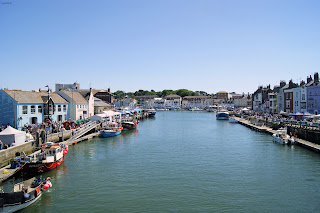 |
| Weymouth Harbour |
Things To See And Do In Weymouth
As a popular seaside destination there is plenty to see and do in Weymouth from an historic port and fort to modern shopping and entertainment. For those who enjoy the beach Weymouth is located on a nice stretch of attractive, sandy shoreline and for those who enjoy the nightlife Weymouth does have a reasonable amount of pubs and bars, but don't let that put you off if you are looking for a family holiday, from my experience Weymouth was never rowdy.
Weymouth Harbour
Weymouth is famous for it's harbour and to this day it is still a busy, thriving, working destination, although most of the boats passing through are for pleasure, it is still a hive of activity all year round and a marina is found at the far end. The history of the harbour can be traced back to Roman times who sailed up the river Wey where they would unload their cargo on route to Dorchester. Boats were sent from Weymouth to help fight against the Spanish Armada in 1588, the harbour was also active during the Civil War when in 1645 fighting broke out whilst trying to hand the harbour back to the control of the reigning monarch, King Charles I. Interestingly a train line, disused since 1987 ran along the harbour, close to the water's edge. Today the Old Town surrounds the harbour, this part of Weymouth is home to many Georgian and Victorian buildings containing a wealth of hotels, guest houses, cafes, pubs, restaurants and shops lining it's narrow streets and is a good spot to watch the world go or sail by. For the photographers out there, a bridge crosses the harbour and offers an excellent opportunity to take photos, this bridge opens up to let tall ships through and is an event that is watched by many of the tourists. |
| Weymouth Harbour A Pleasant Spot To Watch The World Float By |
Weymouth Town Centre
Weymouth town centre has plenty to offer from small, local shops and boutiques, to many of the major department and chain stores that can be found in any large town or city, Marks & Spencer, Boots, Tesco, Iceland, Bon Marche, WHSmith, Burton and Dorothy Perkins can all be found along St.Thomas and St. Mary streets which are the town's main destinations when it comes to shopping and both make for a pleasant walk, each starting at the esplanade and ending at the harbour, and for those in need of a rest a bench won't be far away. As Weymouth is a holiday destination it also offers a range of seaside shops selling all kinds of wonderful and some quite tacky knick-knacks, it wouldn't be a seaside town if there wasn't a bit of tat now would it! There are plenty of good, reasonably priced restaurants and cafes, from greasy spoons and fish and chip shops, to those with a more refined taste. Fans of an alcoholic drink won't be disappointed either with plenty of bars and pubs both local and chain opening late into the evening but for those worried about rowdy crowds, don't be concerned, although there are bars and clubs Weymouth appears to be more of a family oriented destination and not a place for the drunken masses.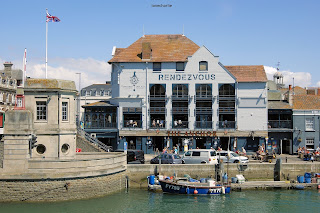 |
| Weymouth Harbour Rendezvous |
Nothe Fort
Built between 1860 to 1872 Nothe Fort was constructed to defend the military base at Portland Harbour, a man made harbour which itself was completed in 1872 and was at the time the world's largest. Located opposite Weymouth Harbour the elevated fort was built on three levels, one for the magazine for ammunition storage a second for cannons and sleeping quarters and a third for firing weapons from. The fort built in the shape of a D also features a large courtyard that is used for public events. When the fort closed in 1956 the local council purchased it in 1961 and has since become a Grade II Listed building.Jubilee Clock Tower
Standing in a prominent location along Weymouth's promenade is a the striking Jubilee Clock Tower, erected to celebrate the Golden Jubilee Of Queen Victoria's reign (50 yrs) in 1887. The four faced, clock tower is made from cast and wrought iron and has since become a focal point along the esplanade.
Standing on a Portland Stone base, the shaft of the tower features decorative drawings of the Queen's head and the Weymouth Coat Of Arms and is topped by an elaborate ogee shaped dome (an ogee is formed from two curving lines somewhat like the letter S). The clock tower was partially paid for by public subscription, when the amount raised failed to reach the required amount however Sir Henry Edwards donated money for the construction while a gas company agreed to light the tower and Weymouth Corporation provided the base. Originally the clock tower jutted out from the promenade into the beach but when the esplanade was widened during the 1920s it was incorporated into the promenade itself, it was also given a more vivid colour scheme.
Standing on a Portland Stone base, the shaft of the tower features decorative drawings of the Queen's head and the Weymouth Coat Of Arms and is topped by an elaborate ogee shaped dome (an ogee is formed from two curving lines somewhat like the letter S). The clock tower was partially paid for by public subscription, when the amount raised failed to reach the required amount however Sir Henry Edwards donated money for the construction while a gas company agreed to light the tower and Weymouth Corporation provided the base. Originally the clock tower jutted out from the promenade into the beach but when the esplanade was widened during the 1920s it was incorporated into the promenade itself, it was also given a more vivid colour scheme.
Sealife Centre Weymouth
Located just along the seafront from Weymouth and the Esplande is the Sealife Centre Adventure Park. Spread across 15 different zones, a wide range of animals call this centre home, including sharks, otters and the world's smallest penguins, apart from the animals there is also an adventure playground and mini golf to keep everyone happy. Prices vary and it is best to look online before you plan your visit.
Weymouth Pier Bandstand
Like many seaside towns across the Uk, Weymouth built it's own pier during the first half of the twentieth century, this pier however was different to most as is it was more of a bandstand than a place for strolling along and relaxation. The Pier Bandstand as it is officially known opened in 1939, with a streamlined, Art Deco design featuring rounded corners and decorative columns, it had a length of 200ft and a seating capacity of 2400, however out of those 2400 seats only 800 were covered and so rain inevitably caused problems. By the 1980s the bandstand had began to age and required costly repairs and so in 1986 it was demolished leaving only the entrance building. Today (2019) the building is home to an amusement arcade and gift shop while the upper floor contains the Italian restaurant Al Molo. The pier is a good place to start or finish your walk along the seafront or indeed just to take a rest before you carry on, public toilets are located at the side of the building.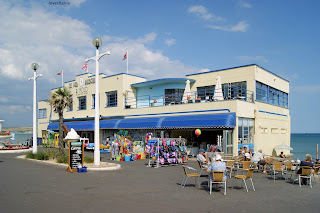 |
| It Was Grand Where The Band Used To Stand At Weymouth Pier |
Weymouth Pavilion
Jurassic Skyline (Demolished)
The Jurassic Skyline was an observation tower located on Weymouth Pier, rising 174ft the tower offers great views over the town and surrounding area. The actual observation desk rising up the shaft and rotates 360 degrees. Due to falling visitor numbers the tower closed for its usual Winter period but failed to reopen in April 2019, it was announced in August that the Jurassic Skyline had closed for good and has since been removed. |
| The Jurassic Skyline You Won't See Any Dinosaurs But You Might Spot Your Holiday Home |


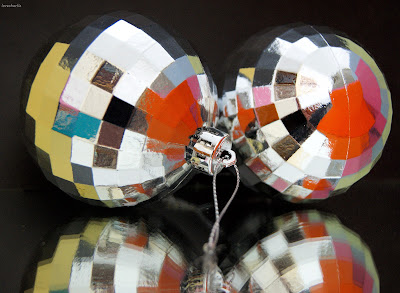
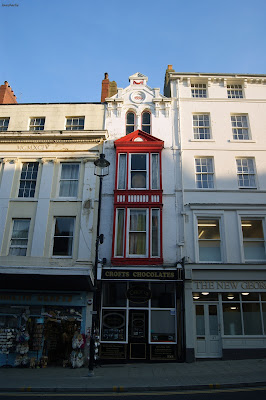
very interesting
ReplyDeleteThanks for the comment, glad u enjoyed reading it!
Delete